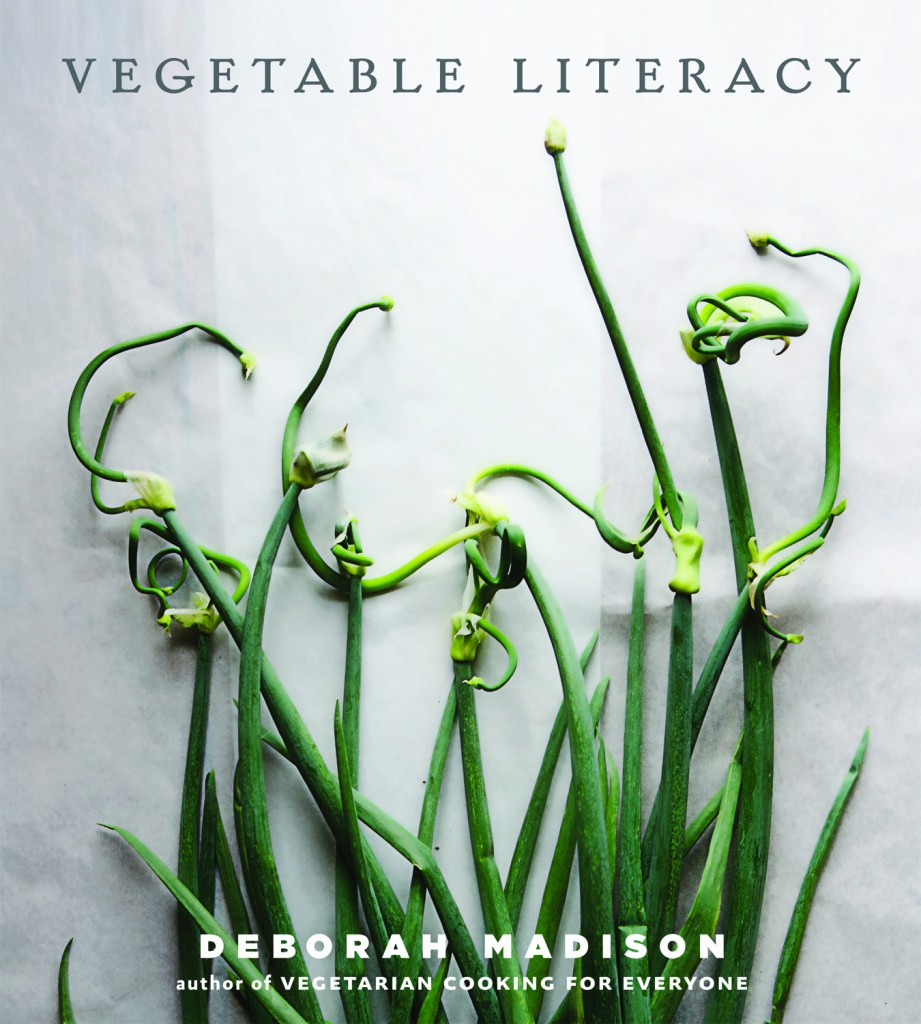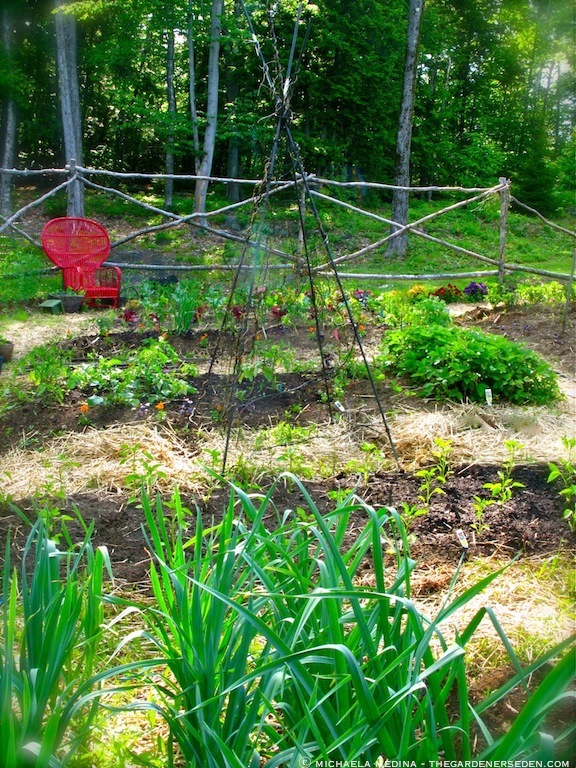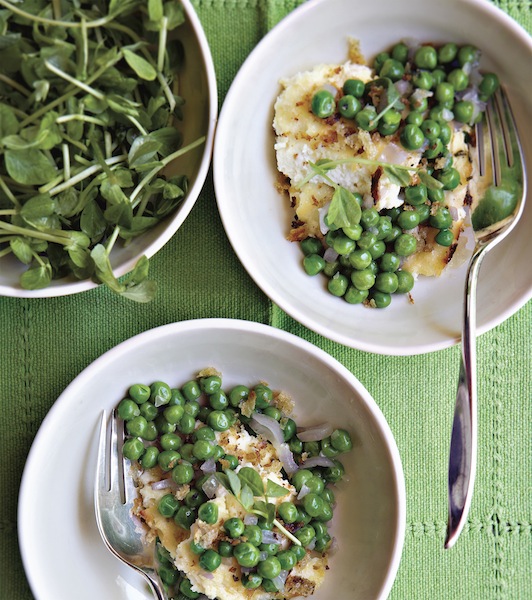Vegetable Literacy by Deborah Madison, Plus a Springtime-Fresh Garden Recipe: Peas with Baked Ricotta & Breadcrumbs
 Vegetable Literacy by Deborah Madison
Vegetable Literacy by Deborah Madison
As organic vegetable gardeners, we know how important it is to become familiar with the various plant families and to develop an understanding of how they relate to one another in the garden. Botanical knowledge is key to avoiding many pests, diseases and cultural problems. Having recently reviewed the topics of crop rotation, companion planting and intercropping in the organic vegetable garden —Kitchen Garden Planning, Part One, followed by Kitchen Garden Planning, Part Two— now seems like the perfect opportunity to discuss how this same botanical knowledge can guide creative use of homegrown produce in your kitchen.
Over the past few weeks, I’ve been devouring Deborah Madison’s Vegetable Literacy, sent to me for review by publisher, Ten Speed Press. One of the most highly-regarded vegetarian cooks of our time, Deborah Madison is author of eleven cookbooks. In her most recent title, Madison explores the relationship between botany and cooking, and how that knowledge can serve us as we prepare produce in our kitchens. A new gardener herself, the author takes a down-to-earth approach; with stories and observations that will be both familiar and inspirational to those who, like Madison, are just beginning to grow their own food. More experienced green thumbs will be delighted by new botanical discoveries and unexpected, creative ways to use the fruits of their labor.
 Â Â Nothing will improve your culinary skills faster than growing fresh produce in your own backyard, and learning how to use those edible flowers, fruits, vegetables and herbs, creatively in your kitchen
  Nothing will improve your culinary skills faster than growing fresh produce in your own backyard, and learning how to use those edible flowers, fruits, vegetables and herbs, creatively in your kitchen
New gardeners will quickly observe that some natural companions in their potagers —tomatoes and basil or garlic and potatoes, for example— are also delightful partners in recipes. In fact, the joy of experimenting with garden fresh ingredients in the kitchen is often what leads a gardener’s hands to soil in the first place. By learning the ways in which edible plants relate to one another, a gardener can become a more versatile and confident cook. Out of onions, spinach or some other key ingredient and need a quick substitute? Looking for a way to jazz up a simple plate of carrots, but haven’t a clue what might work with them? With a bit of coaching from Madison, gardeners may find the creative answers to these culinary challenges, right in the backyard vegetable patch!
Filled with delicious, vegetarian recipes and gorgeous, full-color photographs, Vegetable Literacy is as beautiful to behold as it is delightful to read. Chapters in this cookbook are divided by plant families (Apiacea, Lamiacea, Asteraceae, Brassicaceae, etc.). In addition to 300-plus recipes, the author has included a chef’s notes about her favorite varieties of each edible plant, as well as interesting and useful botanical details for gardeners. I’ve flagged a number of dishes to try with my early crops, but the one featured below, “Peas with Baked Ricotta and Breadcrumbs”, simply couldn’t wait. Although it’s a bit early here in Vermont for garden-fresh peas, I did try this recipe with some of last fall’s bounty (stored in my freezer), and was thrilled with the result. I can’t wait to enjoy this comforting dish again; only next time, with the incomparable flavor of hand-shucked peas, plucked straight from my garden . . .
  Peas with Baked Ricotta & Breadcrumbs from Deborah Madison’s Vegetable Literacy. Photo © 2013 Christopher Hirsheimer and Melissa Hamilton
 Peas with Baked Ricotta & Breadcrumbs from Deborah Madison’s Vegetable Literacy. Photo © 2013 Christopher Hirsheimer and Melissa Hamilton
Peas with Baked Ricotta and Bread Crumbs
A light supper for 2
Olive oil
1 cup high-quality ricotta cheese, such as hand-dipped
full-fat ricotta
2 to 3 tablespoons fresh bread crumbs
4 teaspoons butter
2 large shallots or 1/2 small onion, finely diced (about 1/3 cup)
5 small sage leaves, minced (about 11/2 teaspoons)
11/2 pounds pod peas, shucked (about 1 cup)
Grated zest of 1 lemon
Sea salt and freshly ground pepper
Chunk of Parmesan cheese, for grating
Heat the oven to 375°F. Lightly oil a small baking dish; a round Spanish earthenware dish about 6 inches across is perfect for this amount.
If your ricotta is wet and milky, drain it first by putting it in a colander and pressing out the excess liquid. Pack the ricotta into the dish, drizzle a little olive oil over the surface, and bake 20 minutes or until the cheese has begun to set and brown on top. Cover the surface with the bread crumbs and continue to bake until the bread crumbs are browned and crisp, another 10 minutes. (The amount of time it takes for ricotta cheese to bake until set can vary tremendously, so it may well take longer than the times given here, especially if it wasn’t drained.)
When the cheese is finished baking, heat the butter in a small skillet over medium heat. When the butter foams, add the shallots and sage and cook until softened, about 3 minutes. Add the peas, 1/2 cup water, and the lemon zest. Simmer until the peas are bright green and tender; the time will vary, but it should be 3 to 5 minutes. Whatever you do, don’t let them turn gray. Season with salt and a little freshly ground pepper, not too much.
Divide the ricotta between 2 plates. Spoon the peas over the cheese. Grate some Parmesan over all and enjoy while warm.
With Pasta: Cook 1 cup or so pasta shells in boiling, salted water. Drain and toss them with the peas, cooked as above, and then with the ricotta. The peas nestle in the pasta, like little green pearls.
All Other Photography & Text â“’ Michaela Medina Harlow/The Gardener’s Eden. All images, articles and content on this site (with noted exceptions), are the original, copyrighted property of The Gardener’s Eden and may not be reposted, reproduced or used in any way without prior written consent. Contact information is in the left side bar. Please do not take my photographs without asking first. Thank you!Â
Do you enjoy The Gardener’s Eden? You can help support this site by shopping through affiliate links. A small percentage of each sale will be paid to this site, helping to cover web hosting and maintenance costs. Thank you so much for your support!

6 Replies to “Vegetable Literacy by Deborah Madison, Plus a Springtime-Fresh Garden Recipe: Peas with Baked Ricotta & Breadcrumbs”
Comments are closed.

Oh, this sounds soooo good. I only just planted my peas here in VT, but I’m tempted to buy some just to try this. I bet using a little white wine instead of water when cooking the peas would elevate the whole thing…
Indeed it is delicious, George. And having enjoyed a splash of white wine with my dinner, I completely agree with your suggestion. Can’t imagine a lovelier addition. Enjoy! M
Oh my, made the mistake of opening this post before dinner…
To me, there’s nothing like the colour of perfectly steamed fresh peas (the only problem is, getting enough to land in the bowl without eating them first; )
Sharing your link with some gardening friends, if that’s alright?
Peas, straight from the garden, are beyond compare. I agree with you Deb… The main problem is actually returning with them from the garden. I always eat them on the way! This recipe is impossibly good. Of course, the whole thing depends upon the ricotta. Luckily, I’ve a cheese maker in the town next door. So, so perfect with fresh cheese. Now, for the peas!
And yes, of course… Recipes and blog posts are always made for sharing! Thank you for passing it along :) xo M
ox to you too; )
:D:D:D
Just ordered the book. This recipe sealed the deal on Saturday night. Thnx! Em